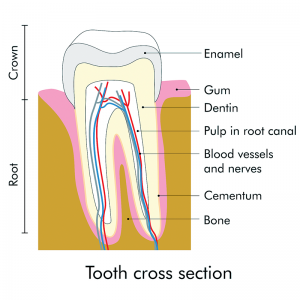Crucial dental process is essential to retaining your teeth
By Dr. Salina Suy
 Happy September everyone! Is it considered fall or summer?
Happy September everyone! Is it considered fall or summer?
I never quite know with these crazy weather patterns.
I hope everyone is enjoying a fresh start back to school with the holiday season right around the corner.
In last month’s “Defining Dentistry” segment, we talked about cavities, how they form and how we treat them. If cavities get very large, they may end up in need of a procedure called a root canal.
What is a root canal?
A root canal is a procedure removing the nerve out of the tooth, cleaning the inside out completely, removing the entire pulp and filling it back up with a biocompatible material to retain the tooth in the mouth.
Why would we need a root canal?
There are several indications for a root canal.
Among the most common reasons are:
— Cavities that reach deep into the tooth pulp chamber
— Dental abscess
— Tooth trauma
— Minimal remaining tooth structure
Remember, if a tooth nerve dies, the only way to remove potential harm is to remove the source of possible infection — the pulp and whole nerve. This can only be done with a root canal or a tooth extraction. When you have a choice, it is always wise to consider saving the tooth.
What is the root canal procedure like?
Well, it depends. Are you infected? Are you in pain? Are you doing this preemptively? Every case is different regarding the patient experience. The procedure itself involves some very common goals however.
Basic steps to root canal:
— Isolate the tooth with a rubber dam
— Take some files down the tooth pulp chamber inside of the tooth and retrieve all of the pulp tissue. Remember, it is in this pulp tissue the nerve and blood vessels live.
— Clean all surfaces of pulp chamber well
— Fill empty pulp chamber with biocompatible packing material
— Restore tooth back to normal (filling, crown, etc.)
After the root canal
Now that the tooth has a root canal treatment, there are a few things we try to have you understand. We have taken the life out of the tooth; it no longer has blood, nerves, oxygen, or nutrient supply. However, thanks to root canal therapy, the tooth can still function normally and remain a healthy part of your smile for years to come.
Over time, the tooth may discolor and lose strength. Imagine if we did the same procedure to your arm. What would happen? The blood, nerve and oxygen supply would cause your arm to grow weaker. This is the same procedure that is essentially happening to your tooth in the jaw.
By doing this, we can retain the tooth body in the jaw and preserve it.
Teeth that are farther back in the mouth — such as molars or premolars — may need crowns to protect them from the forces of chewing after root canal treatment.

Procedures that often accompany root canals are crown build-ups, crowns and clinical crown lengthening. The crown acts as a solid unit to protect the tooth from fracture. It’s a procedure that incorporates many factors, such as size of tooth, strength of patient jaw and unpredictable trauma.
In summary, the root canal is a valuable treatment for dental patients. Patients can seek treatment from their general dentist or specialist.
Each dentist will vary in skill and price range. Ask your dentist when the time is right and what is best for you.
• Salina Suy is a health and wellness advocate and general dentist in Utica. Want to learn more? Visit Facebook @smilewithdrsuy or www.smilewithdrsuy.com.


